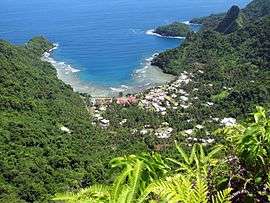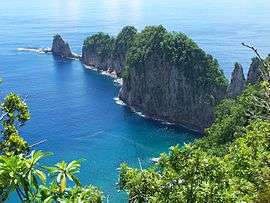National Park of American Samoa
National Park of American Samoa is in the US territory of American Samoa. The Samoan village leaders and the US Congress have set aside the finest samples of these islands' land and seascapes as a national park.
Understand
The National Park samples the best of American Samoa’s scenery, with beautiful shorelines, reefs, and rainforest. It includes three parts, on a total of three islands. All of the park has fine scenery and tropical rainforests. Lata Mountain on Ta’u excels in its wild and remote forests, free-flowing streams, and rugged coastline. Ofu and Olosega have the most accessible coral reefs and miles of breathtakingly beautiful beaches. Tutuila has road-accessible forests, native wildlife, and scenic coastline.
All four islands are extinct volcanoes heavily eroded to rugged peaks. They were formed as the Pacific Plate moved across a stationary hot spot where eruptions from the Earth's mantle pierced the lithosphere forming a line of volcanic islands.
It is the only US National Park south of the Equator.
History
The National Park was established by Congress on 31 Oct 1988. Lands on the islands of Ofu and Olosega were added later.
Landscape

The Samoan Archipelago is a typical Pacific Ocean volcanic island arc. As the Pacific Ocean plate moves across a stationary hot spot (a place where molten rock from the Earth's mantle pierces the lithosphere plate) it forms a line of volcanoes, some of which reach the ocean surface to form a string of islands.
The park in American Samoa adds a unique scenic and ecological dimension to the U.S. National Park System. From ocean depths beyond the reefs to cloud forests on island summits the park has outstanding coral reefs, littoral strand and tropical rainforests on four beautiful, tropical island landscapes.
Fringing coral reefs on the islands of Ofu, Olosega and Ta'u are outstanding marine environments. Their character is crystal clear, warm waters and a bewildering tropical sea biodiversity.
Though the rainforests have long been occupied by humans (the To'aga archaeological sequence on the Ofu section of the park documents 3,000 years of human occupation) the native tropical rainforest is the finest left in the US possessions. Littoral strand, tropical rainforest (montane, ridge top, mountain-top scrub, and cloud forest) are well represented on the Ta'u and Tutuila park segments. With its mid-ocean, Southern hemisphere location the park offers a unique opportunity to sample the renown beauty of the South Pacific.
Flora and fauna
Over 950 species of fish and 250 species of coral live in the reefs surrounding the islands. The animal life of the National Park of American Samoa is unique among the US national parks. Key animal forms (from the flying foxes, or fruit bats, in the mountains to the massive coral reefs along the shorelines) shape all natural ecosystems here. Flying foxes are important terrestrial pollinators and thus, not surprisingly, this rain forest is dominated by fruit-bearing species--in contrast to Hawaii where the native forests are pollinated largely by nectar seeking birds and insects. The coral fringing reefs of the park shelter the greatest marine biodiversity in the U.S. and its possessions. The more than 800 native fish and 200 coral species of the park are bewildering and awesome.
Plant communities of the park, from the mountaintops down to the ocean, are largely tropical rainforest. It is an evergreen forest and the climax vegetation of the equatorial climate. Unlike the temperate forests of North America dominated by one, or only a few tree species, tropical rainforests have high species diversity and the climax forest is dominated by many species.
Samoa, as a geologically young ocean island, lacks any earlier land connection to continental land masses. Because its native species got here by chance its species diversity is not as rich as Southeast Asia, the source of the islands' plant dispersals.
Climate
American Samoa is in the South Pacific Ocean, between the Equator and the Tropic of Capricorn. A tropical climate prevails. Temperatures are warm or hot year-round (high 70s to low 90s °F) with high humidity. Rain showers are frequent. Rain showers may last only for a few minutes, or last all day. The average annual rainfall in the drier portions of the island is 90 inches up to 300 inches in the mountains. Tropical storms are more prevalent during the rainy season (November to May).
Get in

The park is in a remote part of the South Pacific and has limited access, unless you live in Samoa. Therefore, it is likely that more than casual planning is required to visit the park. The only airport is Pago Pago International Airport on Tutuila. Currently two flights a week round trip serve here from Honolulu, from Hawaiian Airliines with a connecting flight in Honolulu, Hawaii. The International Airport at Upolo in nearby (Western) Samoa is served by several flights weekly from Australia, New Zealand and Fiji. Connecting flights serve Tutuila from Upolo by twin-otter aircraft nearly daily.
Irregularly scheduled flights (small planes) serve park areas of Ofu. Currently Inter Island Vacations fly whenever passenger load warrants. Ofu Island is difficult to travel to. Visitors travel by small plane from Tutuila to Ta'u. Then hire a local fisherman and boat to travel to Ofu. The park is open year-round. The visitor center in Pago Pago is open 8AM-4:30PM, closed weekends and federal holidays.
- More information is available by calling the Visitor Center at +1 684 633-7082, ext. 22 or email npsa_info@nps.gov. The park also has a website.
Fees and permits
There are no fees. Reservations are not required.
Get around
Several car rental facilities are available at or near the Tutuila airport. On Tutuila taxis are available at the airport, and near the market in Fagatogo. The island of Tutuila has good public transportation (frequent, but unscheduled) via “aiga” or “family” buses. For $0.50-1 you can be taken around Pago Pago Harbor, and to the more remote parts of the island. Buses originate and terminate at the market in Fagatogo, the village next to Pago Pago. The roads are generally too narrow and the traffic too busy for bicycles.
There are two easy access points:
- Drive from Pago Pago Village towards Fagasa on the paved road to the top of the ridge (Fagasa Pass), where a small parking area and NPS sign mark the trail head for a trail that goes along the ridge above Pago Pago to Alava Mountain.
- The eastern side of the park can be reached by crossing over the ridge above the north side of Pago Pago Harbor from the village of Aua over to Afono. From Afono, continue along the paved road towards the west, entering the park boundary on the ridge above Afono Bay. The road continues on through the park to the village of Vatia. Beyond the school at the far western end of Vatia is an NPS sign marking a trail out towards Pola Tai.
See
- The Tutuila Unit - On Tutuila, the park covers the north-central part of the island from the steep ridge above Pago Pago Harbor to the northern coast. From the road to Fagasa one can hike to the top of the 1,610-foot Mount Alava and have sweeping views of the harbor, Rainmaker Mountain, and the north coastline. A roadway to the village of Vatia crosses Afono Pass and has many fine views. Approaching Vatia are excellent views of Pola Island. Along the way the road crosses Amalau Valley, home of many native birds and flying fox.
- The Ofu, Olosega Unit - The islands of Ofu and Olosega, 60 miles east of Tutuila and accessed by the airport at Ofu, have scenic beaches with spectacular Sunu’itao Peak and Piumafua Mountain backdrops. These islands have good examples of coral reefs in this part of the Pacific, and the best snorkeling waters in the territory.
- The Ta'u Unit - On Ta’u, accessed by the airport at Fitiuta, the trail from Saua around Si’u Point leads to the dramatic southern coastline with views of a rocky coast and sea cliffs stairstep to the 3,000-foot summit of Lata Mountain.
Do

While you are in the park, you should study the tropical wildlife and coral reef marine habitats, and enjoy the many outstanding island and sea landscapes.
Scenic drives
If you’re on Tutuila, stop first at the visitor center in Pago Pago. A scenic road leads from Pago Pago to the north coast. Allow a few hours for this drive, including stops. Along the scenic drive there are panoramic views, especially from Afono Pass. As you approach Vatia there are excellent views of Pola Island. Ofu and Olosega have scenic beaches with spectacular backdrops of Sunu’itao Peak and Piumafua Mountain.
Snorkeling
Ofu and Olosega have good examples of coral reefs in this part of the Pacific, and the best snorkeling waters in the territory. Bring your own snorkel gear, especially when visiting Ofu and Olosega.
Hiking
A hiking trail along the maintenance road leads to the 1,610 ft (490 m) summit of Mt. Alava; the trailhead is at Fagasa Pass, a short drive west of Pago Pago. The hike is 6 miles round trip; allow 3 hours for your hike up and 2 hours for your return to the pass. Ofu and Olosega have extensive stretches of pristine shoreline and fringing reefs, and are the most scenic seascapes in American Samoa. On Ta’u the trail from Saua around Si’u Point leads to the southern coastline of where rocky coast and sea cliffs stairstep to the 3,000-foot summit of Lata Mountain.
Buy
Eat
Popular foods are cocoa rice, pankeke, and pisupo.
Drink
The main "clubbing scene", if you will, is mainly on the island of Tutuila.
Don't be afraid to ask around the community.
Sleep
Lodging
There is no lodging within the park.
The Home Stay program provides an opportunity for visitors to become acquainted with Samoan people and culture in a village setting. Residents of villages associated with the National Park offer accommodations and the opportunity to learn local customs, crafts and the south Pacific lifestyle. Imagine staying in a village with the sights and sounds of the rainforest around you. Sleep in a Samoan house (fale), live with a Samoan family and start the day participating with village activities. Some may be familiar. Others, like cutting the Pandanus (laufala) tree leaves and drying them to weave mats, may not. Add to your weaving knowledge by learning simple methods, like weaving fans from palm leaves.
Camping
Camping is prohibited in the park.
Backcountry
Stay safe
The park's remote location, its lack of search and rescue capability, and the distance from expert medical care require extra precautions:
- Solar radiation is intense!
- Wear sunglasses, sunscreen, a hat, and protective clothing.
- Carry insect repellent.
- Always snorkel with a partner.
- While on beach areas, watch out for falling coconuts.
- Whatever beach you are on be aware of the tidal movements and be alert for the avas - tidal outflows from the reef. These are dangerous - their currents and undertows should not be underestimated.
- Coral rubble beaches are difficult to walk on; watch your step. Be especially careful of rocky areas, which are slippery.
- Ask the Visitor Center about trail conditions.
- Never hike without water; carry 2 to 3 liters per person.
- Don't touch the coral! Cuts from coral take a long time to heal.
- Medical treatment is available on Tutuila.
Go next